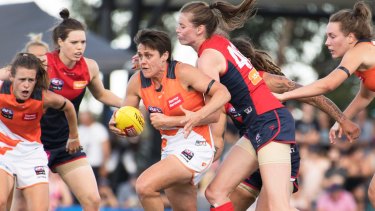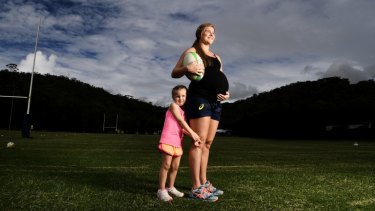It’s the dream of every sporting organisation for women’s sport to have the massive audiences men’s sport has.
But if they want that, they are going to have to pay their players a helluva lot more than they do now. For women to dedicate their lives to being the best they can, the people who employ these athletes must rethink their approach to the working conditions of the women who play. Fine to be all enthusiastic at a marketing level. Now let’s get real. Not every sportswoman can be Serena with perfect entourage on board.
Courtney Gum plays midfield for the Giants and is mum to four-year-old Buzz.Credit:AAP
Serena Williams, extraordinary champion, activist and mother of Olympia, has continued her winning ways after returning from maternity leave. That’s admirable in so many ways and out of the reach of most professional sportswomen in Australia. The women’s games have not yet caught up with what their employees’ lives are like when it comes to the grit and graft of being working parents. Maybe a few of the blokes have stay-at-home partners but women players aren’t paid enough for that.
That’s because their sports don’t really treat them like professionals. Our fabulous AFL players, our basketballers, our cricketers, mostly get treated like first class athletes with second class careers (geez, I don’t know how some of these women pay rent in capital cities and I hope the clubs feed them). For them, there is no Serena entourage and no support from their governing bodies for life as an elite athlete with a baby in tow. Courtney Gum, who plays midfield for the Giants, has some extraordinary stories about what it’s like to manage her professional career with life as a mother of four-year-old Buz.
She tells me she and her partner Krissie (who is an AFL coach) bring their son to training. Neither she nor Krissie earns enough to have extra childcare. Instead Buz is looked after by the player manager Gail Wykes while the women practise. At a post match meeting the other day, Buz came to the door to see what his mum was doing. That’s absolutely natural. And what’s also natural is that it’s nearly impossible to concentrate on what the coach is saying when your bub is waving at you cheerfully from the other side of the room.
Gum was a rookie at 36 and will retire at the end of the year. She says her 37-year-old body can’t cope with six months on and six months off. It’s too hard to keep in shape if she’s not playing so the length of the season also matters. She will return to her physiotherapy practice in South Australia (she worries about the young ones who haven’t finished their studies before they start at the top levels).
Daisy Pearce’s twins Sylvie and Roy.Credit:Twitter: @melbournefc
There are four ways she would love the AFL to change the way it treats its women players: the pay, the length of the season, the promotion of the women’s league compared to the way the men’s league is promoted and, finally, adapting to the life of women with children.
Because those kids are coming. Star Melbourne midfielder Daisy Pearce’s twins arrived last month (the photos are so glorious of Sylvie and Roy in their Demons beanies it made me forget for a minute my devotion to the Swans) and she’s made it plain she wants to return to the game.
Of course, it’s not just AFLW where there’s a gap. Basketballer Liz Cambage, who is set to play in her third Olympics next year and has her eye on a fourth, says she’s keen to start a family. But Cambage asks whether it’s possible to come back to full-time training after a child? How can clubs accommodate that? What support can associations such as Basketball Australia provide?
Thanks for asking! One sport is well on the way with the answers and its story will give you goosebumps. Rugby Australia realised it had a challenge when Nicole Beck played in the gold medal match at the Rio Olympics while pregnant (in case you missed it, we won!). Her case made Rugby Australia sit up, take notice and plan for baby bumps.
Nicole Beck, with 4 year old daughter Sophie. Rugby first sport to nut out policy on what to do with elite female athletes who have children. Credit:Louise Kennerley
Pregnant players at the elite levels of rugby have the offer of a safe job while they can’t train – so an office job while they can’t have contact. And, ohmigod, RA pays for the partner or carer to travel while the player is doing what she does equal best, playing! If the contract expires before the player returns to the team, they are offered a “train and trial period” so they can get back up to full pelt. There’s a few other bits and pieces but this has got to be best on field for pregnancy policies in women’s sport.
These are the kinds of conditions which make it possible for women to be professional athletes. Right now, what we mean when we say professional women athlete is that we expect professional performance without professional pay and conditions.
It can’t work that way. These women are giving us their best. We need to do better by them and so do the associations and clubs which are exploiting a new found interest in women’s sport. Market them better, support them much much better. Recognise that the gap in pay and conditions has an impact on the women and that, in turn, has an impact on the audiences.
Jenna Price is an academic at the University of Technology Sydney.
Source: Read Full Article


